THE INDIAN POLITY AND GOVERNANCE
1. GOOD GOVERNANCE INDEX 2021
THE CONTEXT: Union Minister of Home Affairs released the Good Governance Index 2021 prepared by the Department of Administrative Reforms and Public Grievances (DARPG) on 25 December 2021 which is celebrated as Good Governance Day.
THE EXPLANATION:
Why December 25?
- 25th December is celebrated as Good Governance Day marking the auspicious occasion of late former Prime Minister, Atal Bihari Vajpayee’s birth anniversary. Good Governance is the key component of the economic transformation and with the present government’s focus on ‘minimum government and maximum governance,’ the Index assumes more significance.
What is the Good Governance Index (GGI)?
- GGI is a comprehensive and implementable framework to assess the State of Governance across the States and UTs which enables ranking of States/Districts. The objective of GGI is to create a tool that can be used uniformly across the States to assess the impact of various interventions taken up by the Central and State Governments including UTs.
- Based on the GGI Framework, the Index provides a comparative picture among the States while developing a competitive spirit for improvement. The GGI 2019 encompassed 10 Governance Sectors and 50 Governance Indicators.
- For GGI 2020-21, the same 10 Governance Sectors are retained while indicators have been revised to 58, namely,

Further, the GGI 2020-21 categorizes States and UTs into four categories, i.e.,
- Other States – Group A;
- Other States – Group B;
- North-East and Hill States; and
- Union Territories.
With a “Citizen-Centric Administration” approach at the heart of the government’s Governance Model – this year, 20 States have improved their composite GGI scores over the GGI 2019 index scores.
Data Source:

Top ranking States and UT’s
Analysis of the Index:
- As per the GGI 2021 rankings, Uttar Pradesh has shown an incremental growth of 8.9% over GGI 2019 performance. Among the sectors, it has secured top position in Commerce & Industry sector including an increase in Social Welfare & Development and Judiciary & Public Safety. The state has also performed well in citizen-centric governance including public grievance redressal.
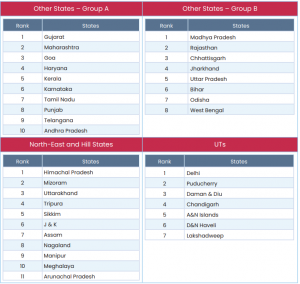
- Jharkhand witnessed a growth of 12.6 per cent over GGI 2019 performance in 7 of the 10 sectors. Rajasthan has shown an incremental growth of 1.7 per cent over the past year’s index and topped the Other States (Group B) category in Judiciary and Public Safety, Environment & Citizen Centric Governance.
- In the North-East and Hill States category, Mizoram and Jammu and Kashmir registered an overall increase of 10.4% and 3.7% respectively over GGI 2019. The latter has performed strongly in Commerce & Industry sector and has improved its scores in Agriculture & Allied Sector, Public Infrastructure and Utilities and Judiciary and Public Safety sectors. Mizoram too has performed strongly in commerce and industry, human resource development, public health and economic governance.
This GGI 2021 indicates that overall governance in the States of India is moving in a positive direction. The end results of these rankings are to improve citizen services and make the government inclusive and accountable.
INDIAN ECONOMY
2. INDIA IMPOSES ANTI-DUMPING DUTY ON CHINESE GOODS
THE CONTEXT: India has imposed anti-dumping duty on five Chinese products, including certain aluminium goods and some chemicals, for five years to guard local manufacturers from cheap imports from the neighbouring country.
THE EXPLANATION:
- According to notifications of the Central Board of Indirect Taxes and Customs (CBIC), the duties have been imposed on certain flat rolled products of aluminium; sodium hydrosulphite (used in dye industry); silicone sealant (used in manufacturing of solar photovoltaic modules, and thermal power applications); hydrofluorocarbon (HFC) component R-32; and hydrofluorocarbon blends (both have uses in refrigeration industry).
- These duties were imposed following recommendations of the Commerce Ministry’s investigation arm, the Directorate General of Trade Remedies (DGTR).
- The CBIC has also imposed the duty on a vehicle component — Axle for Trailers in CKD/SKD (complete and semi knocked down) to protect domestic makers from cheap Chinese imports.
- Similarly it has also slapped the duty on imports of calcined gypsum powder from Iran, Oman, Saudi Arabia and the United Arab Emirates for five years.
What is anti-dumping duty?
- Anti-dumping duty is imposed to rectify the situation arising out of the dumping of goods and its trade distortive effect.
- According to global trade norms, including the World Trade Organization (WTO) regime, a country is allowed to impose tariffs on such dumped products to provide a level-playing field to domestic manufacturers.
How is it different from Counter Vailing Duty?
- Anti-dumping duty is different from countervailing duty. The latter is imposed in order to counter the negative impact of import subsidies to protect domestic producers.
- Countervailing Duties (CVDs) are tariffs levied on imported goods to offset subsidies made to producers of these goods in the exporting country.
- CVDs are meant to level the playing field between domestic producers of a product and foreign producers of the same product who can afford to sell it at a lower price because of the subsidy they receive from their government.
3. WORLD ECONOMY TO TOP $100 TRILLION IN 2022
THE CONTEXT: According to World Economic League Table report released by british consultancy CEBR predicted that China will become the world’s top economy in dollar terms in 2030, two years later than forecast in 2020.
THE EXPLANATION:
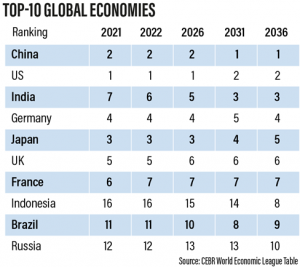
- The world’s economic output will exceed $100 trillion for the first-time next year, and it will take China a little longer than previously thought to overtake the United States as the No.1 economy.
- India looks set to overtake France next year and then Britain in 2023 to regain its place as the world’s sixth biggest economy.
- Also they stated, the important issue for the 2020s is how the world economies cope with inflation, which has now reached 6.8% in the U.S.
- The report showed Germany was on track to overtake Japan in terms of economic output in 2033. Russia could become a Top 10 economy by 2036 and Indonesia looks on track for ninth place in 2034.
What is the current state of Indian economy?
India’s gross domestic product (GDP) at current prices stood at Rs. 51.23 lakh crore (US$ 694.93 billion) in the first quarter of FY22, as per the provisional estimates of gross domestic product for the first quarter of 2021-22.
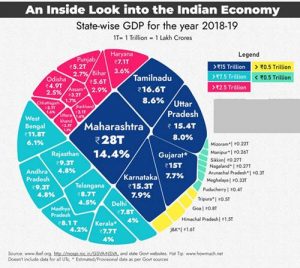
THE SCIENCE AND TECHNOLOGY
4. JAMES WEBB SPACE TELESCOPE MISSION
THE CONTEXT: NASA’s James Webb Space Telescope (JWST) was launched successfully from the European Space Agency’s (ESA) launch base in French Guiana.
THE EXPLANATION:
- NASA’s largest space science telescope ever constructed, will be the successor of the Hubble Space Telescope, that has been in service for more than three decades now.
- The powerful $9 billion infrared telescope, hailed by NASA as the premiere space-science observatory of the next decade, was carried aloft inside the cargo bay of an Ariane 5 rocket.
- According to NASA, the Carrying four main scientific instruments, Near-Infrared Camera, Near-Infrared Spectrograph, Mid-Infrared Instrument, and Near-Infrared Imager and Slitless Spectrograph, Webb will “hunt for the unobserved formation of the first galaxies, as well as to look inside dust clouds where stars and planetary systems are forming today”.
- JWST has the ability to look in the infrared spectrum, which will allow it to peer through much deeper into the universe and see-through obstructions such as gas clouds.
About James Webb Space Telescope (JWST or Webb)
JWST is an engineering marvel comparable to the earth-based Event Horizon Telescope that produced the photograph of the black hole, or the LIGO that detected the gravitational waves. It is widely expected to unveil many secrets of the universe, particularly those related to the formation of stars and galaxies in the early period — the first few hundred million years — after the Big Bang.
- It has been jointly developed by NASA, Canadian Space Agency (CSA) and the European Space Agency (ESA). As NASA’s flagship astrophysics mission, it is planned to succeed the Hubble Space Telescope.
- The primary mirror of JWST that is, Optical Telescope Element, comprises of 18 hexagonal mirror segments. These segments are made up of gold-plated beryllium.
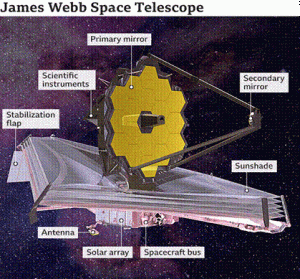
Objectives and functions of the telescope:
- It will look deeper into the cosmos – and thus further back in time – than is possible with Hubble.
- It will do this with a much bigger mirror (6.5m in diameter versus 2.4m) and instruments that are tuned to the infrared.
- Scientists hope this set-up can detect the light from the very first population of stars in the Universe to switch on more than 13.5 billion years ago.
Where it is placed?
The James Webb Space Telescope will not be in orbit around the Earth, like the Hubble Space Telescope is – it will actually orbit the Sun, 1.5 million kilometres (1 million miles) away from the Earth at what is called the second Lagrange point or L2.
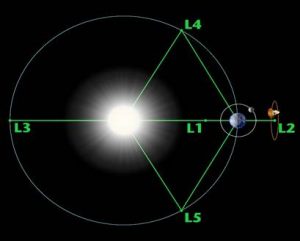
5. THE SMELL FACTOR
THE CONTEXT: Researchers at Karolinska Institute in Sweden have found that negative smells associated with unpleasantness or unease are processed earlier than positive smells and trigger a physical avoidance response.
THE EXPLANATION:
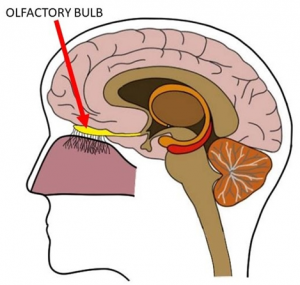
The cognitive process is not only unconscious but is also extremely rapid, this goes against the conventional wisdom that unpleasant smells associated with danger is a conscious cognitive process.
- The olfactory organ takes up about 5% of the human brain and enables us to distinguish between many million different smells. A large proportion of these smells are associated with a threat to our health and survival, such as that of chemicals and rotten food. In humans, the olfactory sense seems particularly important for detecting and reacting to potentially harmful stimuli. Until recently, it was not known which neural mechanisms are involved in the conversion of an unpleasant smell into avoidance behaviour in humans.
- The reason: lack of non-invasive methods of measuring signals from the olfactory bulb, the first part of the rhinencephalon with direct connections to the important central parts of the nervous system that helps us detect and remember threatening and dangerous situations and substances
- According to the National Academy of Sciences release, the three experiments were carried out in which participants were asked to rate their experience of six different smells, some positive, some negative, while the electrophysiological activity of the olfactory bulb when responding to each of the smells was measured. And they found that the bulb reacts specifically and rapidly to negative smells and sends a direct signal to the motor cortex within about 300 milliseconds.
- The researchers have for the first time made it possible to measure signals from the human olfactory bulb, which processes smells and in turn can transmits signals to parts of the brain that control movement and avoidance behaviour.
What are Olfactory Bulbs?
A rounded mass of tissue that contains several types of nerve cells that are involved in the sense of smell. The olfactory bulbs receive information about smells from the nose and send it to the brain by way of the olfactory tracts.
THE GOVERNMENT SCHEMES/ INITIATIVES IN NEWS
6. TELANGANA TOPS IN IMPLEMENTATION OF RURBAN MISSION
THE CONTEXT: Telangana stood first in the implementation of the Shyama Prasad Mukherji Rurban Mission (SPMRM) that was launched in 2016, to stimulate local economic development, enhance basic services and create well planned clusters.
THE EXPLANATION:
- Sangareddy and Kamareddy districts stood in the first two positions among the 300 clusters across the country where the programme was being implemented.
- Tamil Nadu and Gujarat took the second and third positions respectively.
- In Telangana, in as many as 17 clusters (12 non-tribal and five tribal), the programme was being implemented at an estimated cost of ₹1,885.12 crore.
“The establishment of a bulk milk chilling unit at Narayanakhed had benefited about 3,500 farmers, income ranging between ₹50,000 and ₹2.5 lakh per annum, depending on the number of milch animals. A plastic waste treatment unit and millet processing unit are also coming up at Ryakal cluster,”
Value Addition:
SHYAMA PRASAD MUKHERJI RURBAN MISSION (SPMRM)- NATIONAL RURBAN MISSION (NRUM)
Objective
The objective of the National Rurban Mission (NRuM) is to stimulate local economic development, enhance basic services, and create well planned Rurban clusters. It is established in 2016 as a centrally sponsored scheme, and it comes under the Ministry of Rural Development.
Outcomes
- The larger outcomes envisaged under this Mission are:
- Bridging the rural-urban divide-viz: economic, technological and those related to facilities and services.
- Stimulating local economic development with emphasis on reduction of poverty and unemployment in rural areas.
- Spreading development in the region.
- Attracting investment in rural areas.

Rurban Cluster
A ‘Rurban cluster’, would be a cluster of geographically contiguous villages with a population of about 25000 to 50000 in plain and coastal areas and with a population of 5000 to 15000 in desert, hilly or tribal areas. As far as practicable, clusters of villages would follow administrative convergence units of Gram Panchayats and shall be within a single block/tehsil for administrative convenience.
THE PRELIMS PRACTICE QUESTION
Q1. ‘Triclosan’, considered harmful when exposed to high levels for a long time, is most likely present in which of the following?
a) Food preservatives b) Fruit-ripening substances
c) Reused plastic containers d) Toiletries
ANSWER FOR 25TH DECEMBER 2021
Answer: d)
Explanation:
- Statement 1 is incorrect: Indian Constitution provides for the establishment of the Election Commission with the composition of the Chief Election Commissioner and as many Election Commissioners as President may fix from time to time. It is not necessarily a multi-member body.
- Statement 2 is incorrect: CEC and ECs have equal powers and equal salary, allowances which are similar to a judge of a Supreme Court.
- Statement 3 is incorrect: Constitution has not debarred CEC and ECs from any further appointment by the government after their retirement

